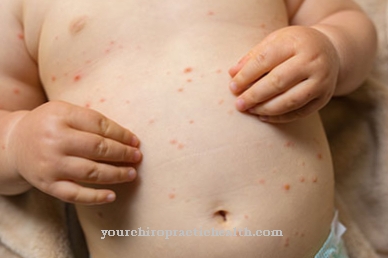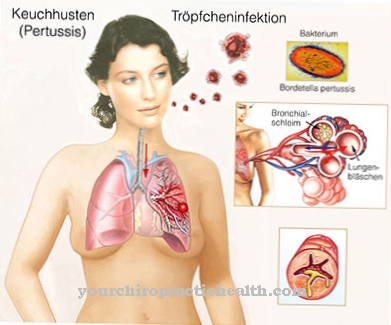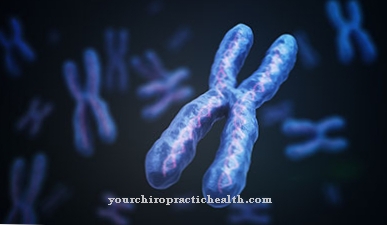At the Naegeli syndrome it is a genetic disease. The Naegeli syndrome becomes synonymous Naegeli-Franceschetti-Jadassohn syndrome called and with the abbreviation NFJ designated. Naegeli syndrome occurs extremely rarely in the population. Basically, Naegeli syndrome is a skin disease characterized by pigment dermatosis of an anhidrotic reticular type. The term disease is derived from the dermatologist Naegeli.
What is Naegeli Syndrome?

© Crystal light - stock.adobe.com
The Naegeli syndrome is a rare hereditary skin disease. It belongs to a certain category of pigment dermatoses. The Naegeli syndrome was first scientifically recorded and described in 1927. The Swiss dermatologist Naegeli plays a central role, after whom the disease was later named.
The doctor identified Naegeli syndrome in a family. Both the father and the two daughters were affected by the skin disease, so Naegeli gave a comprehensive medical description. In 1954 the same family took part in another research study on Naegeli syndrome. The doctors Franceschetti and Jadassohn were mainly involved here. The two doctors found that Naegeli syndrome has an autosomal dominant inheritance.
In principle, Naegeli syndrome is one of the least common diseases. Because according to the current state of research with regard to the disease, Naegeli syndrome was only diagnosed in five families and their subsequent generations. This shows an equal frequency of illness in female and male patients.
causes
The triggers of Naegeli syndrome lie in the genes of the sick person. A certain genetic mutation on the 17th chromosome is responsible for the later manifestation of Naegeli syndrome. The genetic defect is located exactly on the gene called KRT14, which is related to the substance keratin. Naegeli syndrome is inherited in an autosomal dominant manner in the offspring of those affected.
Symptoms, ailments & signs
Special changes and abnormalities in the skin are typical of Naegeli syndrome. The complete absence of fingerprints, for example, is particularly characteristic of Naegeli syndrome. In addition, the skin surface all over the body is characterized by a special hyperpigmentation.
Its shape is reminiscent of a network structure. However, this phenomenon regresses the older the people with Naegeli syndrome get. Another widespread symptom is the inability of the affected person to remove sweat from the body through the skin and sweat glands.
Even with correspondingly high air temperatures, the sick patients are not able to sweat. This phenomenon is known in medicine as anhidrosis and is the most complicated symptom of Naegeli syndrome. In addition, those affected usually lose all of their teeth.
In the majority of patients, this tooth loss already occurs in childhood or adolescence. In connection with this, abnormalities can be observed in the patient's dentine. In addition, blisters develop on the skin of some sick people.
The toe nails may be deformed. However, all the symptoms of Naegeli syndrome decrease with age. Numerous symptoms of Naegeli syndrome show parallels to those of Bloch-Sulzberger syndrome, which is why a corresponding differential diagnosis is urgently necessary.
Diagnosis & course of disease
The diagnosis of Naegeli syndrome is carried out by a specialist doctor and, with regard to the genetic causes and the rarity of the disease, usually takes place in a medical center. At the beginning it is necessary to take an anamnesis, in which the attending physician takes the patient's medical history and analyzes the symptoms.
Carrying out a family history is particularly important for the diagnosis of Naegeli syndrome, as this quickly provides indications of the existing disease. Following the first patient consultation, the specialist examines the sick person using clinical examination procedures. In addition to a general visual examination, the skin of the affected person in particular is examined.
In many cases, the doctor will take samples of specific areas of the skin and have the tissue examined in the laboratory. The abnormalities on the teeth are usually examined by dentists and orthodontists. For this purpose, people affected by Naegeli syndrome usually undergo an X-ray examination.
To complete the diagnosis of Naegeli syndrome, a genetic analysis of the affected person's DNA is usually performed. In this way, the Naegeli syndrome can be reliably identified. In addition, a differential diagnosis is required for Naegeli syndrome, whereby the doctor differentiates the disease from epidermolysis bullosa simplex and dermatopathia pigmentosa reticularis, for example. Bloch-Sulzberger syndrome can also be ruled out.
Complications
With Naegeli syndrome, those affected usually suffer from various skin complaints. The fingerprints are completely missing, although there are usually no particular complications in everyday life for the person concerned. Hyperpigmentation can also occur, so that those affected are often ashamed and uncomfortable with this symptom.
This can lead to inferiority complexes that affect the quality of life. Likewise, those affected cannot sweat, so that the heat cannot be properly dissipated during physical exertion. This syndrome also often causes various complaints to the teeth, so that those affected lose their teeth completely.
The skin can also develop blisters. In many cases, those affected suffer from bullying and teasing, especially in childhood. Due to the loss of teeth, the patient can usually no longer eat food in the normal way. A causal treatment of this disease is usually not possible. When treating the symptoms themselves, there are no particular complications.
When should you go to the doctor?
If skin abnormalities and hyperpigmentation appear, it is clear evidence of a serious condition.A doctor must determine whether this is Naegeli syndrome or another disease and, if necessary, initiate treatment. If further symptoms such as a rapid deterioration in dental health or the formation of skin blisters are noticed, the family doctor must be informed. Since Naegeli syndrome is a hereditary condition, the diagnosis should be made in childhood.
Parents who notice such symptoms in their child are best advised to consult their family doctor or a specialist. In later life, the child must be closely monitored by a doctor, as the disease is always associated with complications. People who suffer from the disease themselves should have a genetic test during pregnancy in order to be certain about the child's health. The treatment is carried out by a dermatologist as well as internists, surgeons and specialists for the respective condition.
Treatment & Therapy
Naegeli syndrome is genetic, which is why effective treatment of its causes is impractical. However, medical research is working on ways of prophylaxis and therapy for hereditary diseases. Thus, all technical treatment measures for Naegeli syndrome concentrate on the patient's complaints.
The changes in the skin in most cases improve as the person ages. Loss of teeth can be largely compensated for by orthodontic measures and dentures.
You can find your medication here
➔ Medicines against redness and eczemaOutlook & forecast
The prognosis for Naegeli syndrome depends on the symptoms. Individual complaints such as anhidrosis and the deformation of the toenails can cause discomfort over a longer period of time. The patients suffer from a reduced well-being and often feel socially excluded because of their illness. As a result of the physical changes, inflammation can also occur, which further worsens the prognosis.
After tooth failure, it becomes difficult to eat and patients often develop deficiency symptoms or become dehydrated. Itching or pain may occur as a result of the inflammatory skin diseases. As a result, the psychological stress often increases for the patients because they are marginalized due to the external changes.
Very rarely, chronic complaints can develop from the skin diseases. Eczema or fistulas, which worsen the prospect of a full recovery, are typical. The prognosis is accordingly difficult, since both the disease itself and the symptoms and their consequences reduce the quality of life. Life expectancy is not necessarily restricted. The doctor responsible will provide the exact prognosis. Patients with Naegeli syndrome need comprehensive treatment to achieve a better prognosis.
prevention
There are no options to prevent Naegeli syndrome. The disease is inherited in an autosomal dominant manner from the parents to the offspring, so that some of the daughter generations show the Naegeli syndrome in the phenotype. Basically, the prognosis for Naegeli syndrome is positive, as the symptoms subside over the course of life.
Aftercare
In most cases, those affected have only very few and usually only very limited aftercare measures available for Naegeli syndrome. For this reason, the person affected should consult a doctor very early so that the occurrence of other complications and complaints can be prevented. Since this is a genetic disease, a complete cure can usually not be achieved.
If the person concerned wants to have children, he or she should undergo genetic testing and counseling to prevent the syndrome from recurring. In most cases, those affected themselves have to rely on various medications. It is always important to take it regularly and to use the correct dosage in order to permanently alleviate the symptoms.
In the event of side effects or uncertainties, a doctor should first be contacted. Discomfort on the skin can be relieved relatively well with the help of special creams or ointments. Regular checks and examinations by a doctor are also necessary. As a rule, Naegeli syndrome does not reduce the patient's life expectancy. There are no further follow-up measures available to the affected person.
You can do that yourself
Since Naegeli syndrome is a genetic disease, the individual complaints can only be dealt with symptomatically. The patient can take some measures himself to support the medical treatment.
First of all, it is important to observe strict personal hygiene. By brushing your teeth regularly, you can at least delay the loss of your teeth. In addition, the health of the toes can be preserved by regularly cleaning them carefully and treating them with medical products. The doctor can answer which measures make sense here in terms of the stage of the disease. The most visible skin changes can be counteracted by wearing concealing clothing. Treatment of hyperpigmentation is not possible, which is why the doctor will recommend therapeutic advice in order to avoid the development of psychological complaints.
Those affected who are already severely affected by the psychological effects of Naegeli syndrome should also consult a self-help group and talk to other affected persons. Should blisters develop or other complications arise, further self-help measures should not be taken. The doctor must be informed so that medical treatment can be initiated quickly.






.jpg)






.jpg)

.jpg)
.jpg)











.jpg)